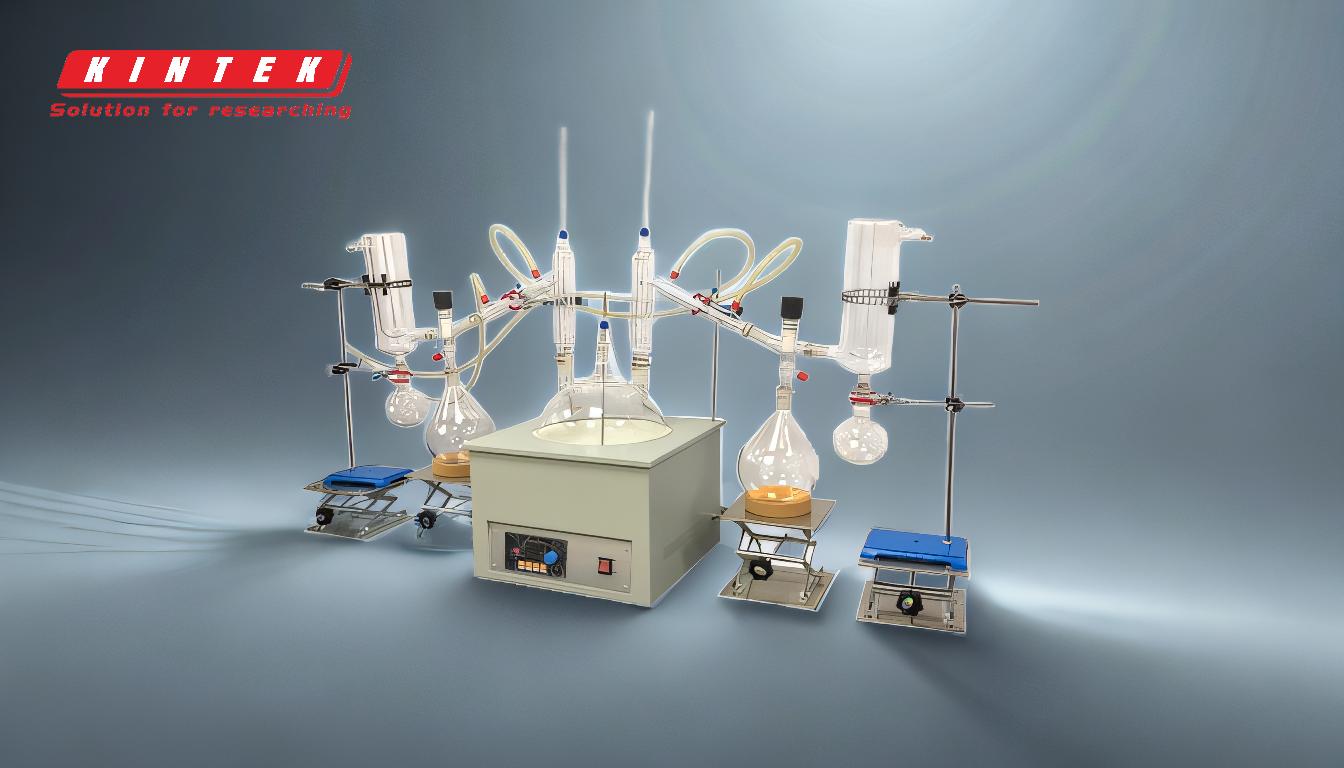Distillation is a fundamental separation technique used to separate liquids based on their boiling points. The process involves heating a liquid mixture to vaporize the component with the lower boiling point, then cooling the vapor to condense it back into a liquid for collection. Different types of distillation are employed depending on the specific requirements of the separation, such as the nature of the substances involved, their boiling points, and the desired purity of the final product. The main types of distillation include simple distillation, fractional distillation, steam distillation, vacuum distillation, and short path distillation. Each method has unique characteristics and applications, making them suitable for different scenarios in both laboratory and industrial settings.
Key Points Explained:

-
Simple Distillation:
- Process: Simple distillation involves heating a liquid mixture to its boiling point, allowing the more volatile component to vaporize. The vapor is then condensed back into a liquid and collected.
- Applications: This method is typically used for separating liquids with significantly different boiling points (e.g., water and salt) or for purifying a single liquid from non-volatile impurities.
- Limitations: Simple distillation is less effective for separating liquids with close boiling points, as it does not provide sufficient separation efficiency.
-
Fractional Distillation:
- Process: Fractional distillation uses a fractionating column, which provides multiple vaporization-condensation cycles. This enhances the separation of liquids with closer boiling points.
- Applications: Commonly used in the petroleum industry to separate crude oil into its various components (e.g., gasoline, diesel, kerosene) and in the production of alcoholic beverages.
- Advantages: Offers higher separation efficiency compared to simple distillation, making it suitable for complex mixtures.
-
Steam Distillation:
- Process: Steam distillation involves passing steam through a mixture, which lowers the boiling points of the components, allowing them to vaporize at lower temperatures. The vapor is then condensed and collected.
- Applications: Primarily used for extracting essential oils from plant materials and for separating heat-sensitive compounds that might decompose at higher temperatures.
- Advantages: Gentle on heat-sensitive materials and effective for separating compounds that are immiscible with water.
-
Vacuum Distillation:
- Process: Vacuum distillation is performed under reduced pressure, which lowers the boiling points of the components, allowing them to vaporize at lower temperatures.
- Applications: Used for separating high-boiling-point liquids or heat-sensitive compounds that would decompose at their normal boiling points. Common in the chemical and pharmaceutical industries.
- Advantages: Reduces the risk of thermal decomposition and is suitable for compounds with high boiling points.
-
Short Path Distillation:
- Process: Short path distillation involves heating the mixture in a vacuum and condensing the vapor over a short distance, minimizing the exposure to heat and reducing the risk of decomposition.
- Applications: Often used in the purification of sensitive compounds, such as certain pharmaceuticals, essential oils, and cannabinoids.
- Advantages: Provides high purity and is particularly effective for heat-sensitive materials.
-
Air-Sensitive Vacuum Distillation:
- Process: This method is similar to vacuum distillation but is specifically designed for compounds that are sensitive to air or moisture. The entire process is conducted in an inert atmosphere.
- Applications: Used in the purification of air-sensitive compounds, such as certain organometallic compounds and reactive chemicals.
- Advantages: Protects sensitive materials from degradation due to exposure to air or moisture.
-
Zone Distillation:
- Process: Zone distillation involves the repeated melting and solidification of a material in a controlled manner, allowing impurities to be separated based on their solubility in the solid and liquid phases.
- Applications: Used in the purification of metals, semiconductors, and other materials where high purity is required.
- Advantages: Provides extremely high purity levels and is effective for materials that are difficult to purify by other methods.
In summary, the choice of distillation method depends on the specific requirements of the separation process, including the nature of the substances involved, their boiling points, and the desired purity of the final product. Each type of distillation offers unique advantages and is suited to particular applications, making distillation a versatile and essential technique in both laboratory and industrial settings.
Summary Table:
| Type of Distillation | Key Process | Applications | Advantages |
|---|---|---|---|
| Simple Distillation | Heating to vaporize the more volatile component, then condensing it. | Separating liquids with significantly different boiling points or purifying single liquids. | Simple and effective for large boiling point differences. |
| Fractional Distillation | Uses a fractionating column for multiple vaporization-condensation cycles. | Petroleum refining, alcoholic beverage production. | High separation efficiency for complex mixtures. |
| Steam Distillation | Steam lowers boiling points, allowing vaporization at lower temperatures. | Extracting essential oils, separating heat-sensitive compounds. | Gentle on heat-sensitive materials. |
| Vacuum Distillation | Conducted under reduced pressure to lower boiling points. | Separating high-boiling-point or heat-sensitive compounds. | Reduces thermal decomposition risk. |
| Short Path Distillation | Heating in a vacuum with minimal heat exposure. | Purifying sensitive compounds like pharmaceuticals and cannabinoids. | High purity for heat-sensitive materials. |
| Air-Sensitive Vacuum Distillation | Conducted in an inert atmosphere for air-sensitive compounds. | Purifying organometallic compounds and reactive chemicals. | Protects materials from air or moisture degradation. |
| Zone Distillation | Repeated melting and solidification to separate impurities. | Purifying metals and semiconductors. | Extremely high purity levels. |
Need help choosing the right distillation method for your application? Contact our experts today!










